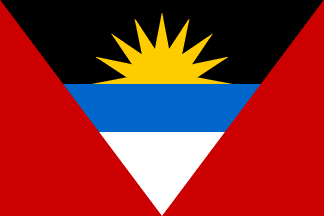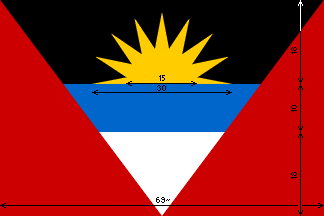 (~2:3)
(~2:3) image by Željko Heimer, 12 January 2004
image by Željko Heimer, 12 January 2004
Last modified: 2023-06-03 by rob raeside
Keywords: antigua | barbuda | caribbean | america | antigua and barbuda | agave | west indies | leeward islands |
Links: FOTW homepage |
search |
disclaimer and copyright |
write us |
mirrors
 (~2:3)
(~2:3) image by Željko Heimer, 12 January 2004
image by Željko Heimer, 12 January 2004
Official Name: Antigua and Barbuda
Capital: St. John's
Location: Caribbean
Government Type: Constitutional Monarchy (Queen
Elizabeth II)
Flag adopted: 27
February 1967
Designer: Mr. Reginald Samuel
Coat of arms adopted: 16 February 1967
ISO Code: AG
See also:
Antigua and Barbuda's flag was designed by Mr. Reginald
Samuel, an art teacher in an Antiguan high school, when
Antigua gained "statehood" status (Self-governing) in
1967.
L. Jacobs II , 21 September 1998 and Ivan Sache ,
31 January 2000
Acording to L'Album 2000 [pay00]
the construction details are stripes in ratio 18:10:18, lenght
69~ [so total ratio 2:3~]. Is this based on some official data?
[smi80] have as civil ensign for
Antigua and Barbuda to be the british red ensign, but here the
national flag is indicated to be (among other uses) civil ensign
too. Is that changed since 1980?
Željko Heimer, 5 January 2001
I visited Antigua in spring 1994 and I saw there a lot of
national flags, both on land and at sea.
Ivan Sache, 6 January 2001
The flag is national flag and ensign (i.e. CSW/CSW). The flag
was adopted, apparently only for the use on land in 1967, but the
flag must have been introduced into maritime use since 1981 when
Antigua and Barbuda aquired full independence. Until 1981 the
undefaced red ensign was the civil ensign in Antigua and Barbuda.
Was there any defaced blue ensign?
History of the status of AG could be quoted from rulers site
<www.geocities.com/Athens/1058/rulers.html> (defunct) :
Željko Heimer, 12 January 2001
Example of gold on flags as opposed to yellow was given
recently by the embassy of Antigua Barbuda in London, who sent a
delivery of flags back to their manufacturer recently on the
grounds that they (the manufacturers) had used yellow where the
law stipulates a 'golden' sun.
Christopher Southworth, 28 March 2003
In corr. 3 (2003) of Album des Pavillons [pay03], I have presented AG Coast Guard Ensign, and consequently AG flag
as CSW/C--.
Armand Noel du Payrat, 24 June 2003
An article
"courtesy The Museum of Antigua & Barbuda and The
Dockyard Museum" related the adoption process of the flag as
follows: "In 1966, a national flag design competition was
held for the occasion of attaining Independence in Association
with Great Britain on February 27th, 1967. There were over 600
entries, with Mr. Reginald Samuel winning the first prize of $500
for the best design. He had entered the very last minute before
the deadline, and made the design in only about half an hour. He
rushed to buy an envelope to get the entry to the Administration
building in time. Later he heard he had won!
Mr. Samuel is an Antiguan artist, sculptor, painter and art
teacher. The winning design, together with the chosen anthem,
coat-of-arms and slogan, was displayed on a board outside the
Administration Building next to the Post Office, so the people of
Antigua and Barbuda could see their future devices. That original
board may now been seen as an exhibit at the Museum of Antigua
and Barbuda. The 7 point golden sun of the Antigua & Barbuda
flag represents the dawn of a new era. The colour red, the life
blood of slave forefathers and the dynamism of the people. Blue
represents hope, black, the soil and African heritage and gold,
blue & white Antigua's and Barbuda's tourist attractions sun,
sea and sand. The "V" formed by the red borders
represent: "Victory at last." In 1994, it was decided
that seven full points of the sun should be displayed for many as
twenty had sometimes been shown! It has been suggested that
these seven points should represent the six parishes plus our
sister island, Barbuda, though the designer himself did not have
this in mind."
A wire by the agency CMC, reprinted in the Jamaica
Observer, 2 November 2006, reports that the very same
Reginald Samuel, now Sir Reginald Samuel, was among the 12 people
recognised on 1 November by the Antigua and Barbuda government
for their contribution to sports. Reginald Samuel, former
Director of Sport, was bestowed with knighthoods, the second
highest award.
Ivan Sache, 2 November 2006
The sun represents the dawning of a new era; red - the energy
of the people; blue - hope; black, the African ancestry of the
people. The combination of yellow, blue and white represent the
sun, sand and sea.
James Dignan , 22 November 1995

image by Željko Heimer, 12 January 2004
The construction sheet is made according to the data given in
l'Album 2000 [pay00]. Overall
ratio 2:3~ is approximated as (18+10+18):69~. The sun symbol is
half of a 16-pointed star with outer diameter 30 and inner 15
units. The colours provided are approxiamtive. The red is
apparently the same as the red of the british ensigns (Pantone
186c). Blue is somehwat lighter then the standard British ensign
blue (Pantone 300c) and yellow is aproximated with Pantone 116c.
Željko Heimer, 12 January 2001
Construction number 30 and 15 are my approximation, other
figures from Album 2000. Chris' has different number but without
official source: (39+22+39):150 with sun diameters 68 and 40.
Željko Heimer, 15 January 2004
The protocol manual for the
London 2012 Olympics
(Flags and Anthems Manual
London 2012 [loc12]) provides recommendations
for national flag designs. Each
NOC
was sent an image of the flag, including the
PMS shades, for their approval by LOCOG. Once this was obtained, LOCOG produced
a 60 x 90 cm version of the flag for further approval. So, while these specs may
not be the official, government, version of each flag, they are certainly what
the NOC
believed the flag to be.
For Antigua and Barbuda: PMS 032 red, 300 blue, 109 yellow and black. The
vertical version is simply the flag turned through 90 degrees clockwise.
Ian Sumner, 10 October 2012
According to this WMO
page, Antigua and Barbuda use signals 40a and 41a which are
red pierced black and red pierced black (double),
respectively.
40a is defined as Tropical disturbance reported; likely to affect
the islandh whereas 41a means Hurricane warning. Danger expected.
Jan Mertens, 1 November 2007